Masterpieces at a Leyden Home
By Peter J. Koehler
When reading the name Sylvius, most neurologists will think of neuroanatomic structures like the aqueduct and the lateral fissure of the hemispheres. Descendant from a Protestant family from northern France (the city of Cambrai that at the time was situated in the southern Netherlands), Franciscus dele Boë (1614-1672), also known as Sylvius, was born in the German town of Hanau, east of Frankfurt-am-Main.
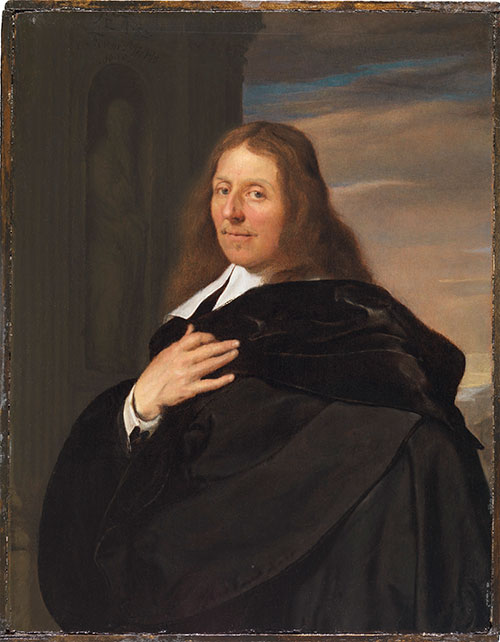
Sylvius by Frans van Mieris I (1665, oil on
panel, 18,8×14,2 cm, New York, private
collection; see also The Leiden Collection
FM-104).
He studied medicine in Sedan and Leyden, made a peregrination to southern German universities and defended a thesis at the university of Basel, Switzerland (1637). He graduated a second time the following year at Leyden university.
He became famous for his anatomy lessons, at the time including physiology. He demonstrated the circulation of the blood as published by William Harvey (1578-1657) a few decades previously (De motu cordis, 1628).
“Many students, and certainly not the worst ones, attended his courses, so that it seemed as if only he could understand and explain anatomy.” Among his students was Danish Thomas Bartholinus (1616-1680), son of the famous anatomist Caspar (1585-1629). Thomas’s notes of Sylvius’s course of the early 1640s was included in his father’s Institutiones anatomicae (1641 edition). Caspar Bartholinus wrote “we cannot pass by the very accurate anatomist D. Franciscus Sylvius; from his noble mind and ingenuity we take the admirable new structure of the brain.”
Following a period of practicing general medical in Amsterdam (1641-1658), where he lived at the Keizersgracht [canal], and during which he enjoyed chemistry and anatomy in his leisure time, he returned to Leyden to become professor of medicine. He gave bedside teaching in the nearby Caeciliahospital and studied the pathological changes at autopsy.
Fissure of Sylvius
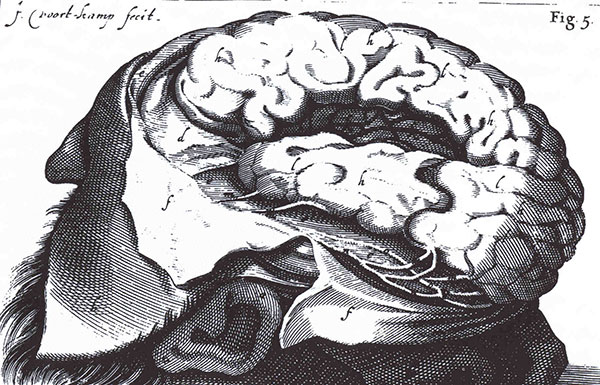
Fissura Sylvii.
He attracted many foreign students, including Danish Niels Stensen (“Steno”; 1638-1688), who wrote that Sylvius’s method of brain dissection was a combination of the ancient Galenic approach and the more recent method of Costanzo Varolio (1543-1575).
The latter cut the brain from its base to above, thereby improving the visualization of structures at the base, including the cranial nerves and the pons (Varolius). Another pupil, Gabriel Ypelaer, defended a thesis under Sylvius’s supervision, in which he presented a description of the lateral fissure (1660). Sylvius published it three years later in his own Disputationem medicarum decas.
In 1774, the Swiss Albrecht von Haller (1708-1777) emphasized that this was probably the first description of the fissure. Sylvius’s name became also associated with the aqueduct, although many refer to the homonymous teacher of Andreas Vesalius (1514-1564), Paris anatomist Jacobus Sylvius (1478-1555).
Probably the structure had already been observed by others before Jacobus Sylvius, although there is discussion on whether they really saw the small canal. The Leyden Sylvius, however, described the “canalis vel aquae-ductus” between the converging “roots of the spinal cord” and the corpora quadrigemina below “our bridge” (Disputationem (1663; chapter 21).
With respect to physiology, Sylvius rejected the classical qualities and humors, retaining the concept of animal spirits that were used in the brain and sent to the muscles through the nerves. He adhered to a kind of chemical humoral pathology that became known as iatrochemistry, in which effervescense, a vehement reaction between acid and alkaline secretions occur, for instance, in the right ventricle of the heart or the duodenum.
Collecting Masterpieces
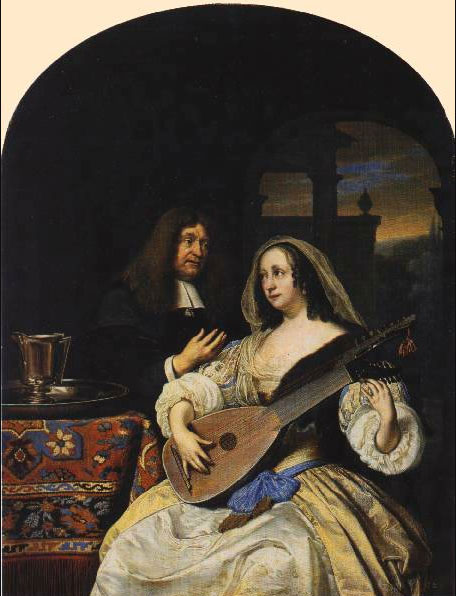
Sylvius and his wife / “The music lesson”
by Frans van Mieris I (1672, oil on
panel, 41×31 cm, courtesy Staatliche
Kunstsammlungen Dresden – Gemäldegalerie
Alte Meister, Dresden, inv. no. 1743).
Sylvius’s first wife, Anna de Ligne, whom he married in 1649, died the year before he moved back to Leyden. Their two children also died at a young age. Arriving in Leyden, he bought a nice house at Rapenburg (on a canal) no. 31, not far from the university building. He had it converted (for 10.500 guilders) into a distinguished home with dining room and salon.
Other houses at the Rapenburg were owned by upper-class Leiden citizens, including city official, merchants, and like Sylvius, university professors. An inventory of his house in 1673, half a year after his death, shows that he had been the owner not only of a considerable library, comprising hundreds of medical, chemical, and religious books, but also one of the largest painting collections of the city.
It seems that at the time he was a patron for contemporary painters, including Experiens Sillemans (1611-1652/3; six paintings) and Simon Luttichuys (1610-1661; six) from Amsterdam, and Gerrit Dou (11) and Frans van Mieris I (7) from Leiden. Among the latter painter’s works, Sylvius owned “The music lesson” with portraits of Sylvius and his second wife Magdalena L. Schletzer, whom he had married in 1666. During the plague of 1669, Sylvius became severely ill, but survived. However, his young wife (21 years old) died, even before Van Mieris finished the painting. It was hanging in Sylvius’s front room. For Van Mieris, Sylvius was “zynen Mecenas” [his Maecenas]. Dutch writer and painter Arnold Houbraken (1660-1719) wrote: “Professor Silvius, welke laatste dikwerf verzogt, dat al wat hy maakte voor hem mogt wezen” [Professor Sylvius, the latter who often asked that all what he made might be for him] (Houbraken, 1721, p. 3).
Next to the painting with his second wife, Van Mieris painted another portrait of Sylvius (1665, see above, he inscribed the age of the person 52, which should have been 50 or 51).
Furthermore, Sylvius owned works by Roelant Savery (1576-1639), Paulus Potter (1625-1654), and Philips Wouwerman (1619-1668), in particular animal scenes. Imagine living in such a kind of art gallery! A reconstruction of his home showed that he had 22 paintings in his dining room (including the five senses by Jan Miense Molenaer), 34 in his large salon, 26 in a side chamber, 16 in the upper back chamber, and 42 (including Van Dyck’s portrait of King Charles of England) in the master bedroom that was arranged as a kind of Kunstkammer.
Apparently, he did not collect everything from his surroundings, as is demonstrated by the fact that he did not have any of the moralizing genre pieces by Jan Steen (1626-1679) or landscapes of Jan van Goyen (1596-1656).
The Quack and (Brain)Stones
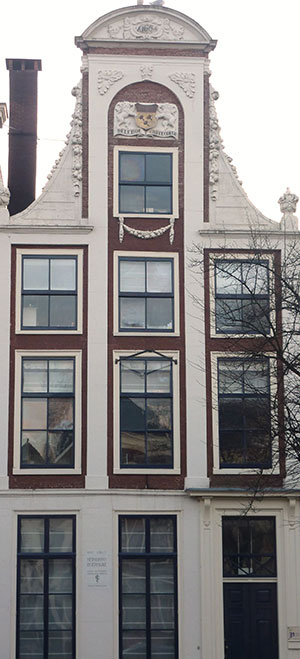
Sylvius’s house in Leyden at Rapenburg 31.
Since Jheronimus Bosch’s painting “Cutting the stone,” similar scenes have been depicted in paintings and engravings during the 16th and 17th century (see World Neurology 2017, January, pp. 6-7). Adriaen Brouwer’s (c.1605-1638) “Quacksalver,” now possessed by the Kunsthalle in Karlsruhe), was hanging in Sylvius’s entry room. Although it is not a representation of the actual procedure of “cutting the stone,” stones are depicted hanging on pieces of red string on the quack’s banner, in a way that can observed in several other paintings. It would indicate examples of stones that the quack had removed in the past from the heads of other patients. Even a knife has been attached to the banner.
The place of action is a market square, where a quack, who has relatively short legs, with long hair, a beard, and moustache, is standing on a partly sawed off or buried barrel. He is wearing a red hat with feathers, a yellow coat with blue stripes, and brown trousers. These clothes remind of the Italian comedy (commedia dell’arte), which was sometimes applied by painters. A dagger is attached to his belt. He seems to be looking at the viewer.
In his left hand, he has a small pot and with the index finger of the right hand he probably takes some ointment. Around the table in front of him, we see adult people, probably peasants listening and looking to the objects on the table. There are also some children. The one with the red beret with white feather and pink coat may be doing some mischief. The woman in brown blouse and white bonnet behind the table, laughing to the quack possibly took the plug from the bottle with the blue fluid, or is she emptying a small pot? To the right-hand side, a woman in pink coat with white bonnet and apron, is sitting on a low bench. A man in front of her seems to be explaining what is happening; he is pointing to the quack.
Two other persons, one with a red cap and the other a black beret, behind that man are discussing the scene. A man, leaning on the windowsill of the opened window above, and a woman behind him, are also listening. A number of objects are displayed on the table, including a small bottle with a plug, a spatula – it may be pointing in an intended direction – and a bowl with a triturator. A big knife is hanging from the edge of the table.
At the background to the left, we see a farmer’s house and a church (and some persons, one of whom is obeying nature’s call near the tree) and to the right façades of six houses in a row. Deception of the credulous peasants seems to be the main subject of this scene.
If the viewer would still have doubts, the painter added, on the upper right corner of the banner, some letters: “JAN CERNAKEL.” This is a reference to Bruegel’s “Witch of Mallegem,” where it is spelled with a “k” instead of “c.” The German world “Karnickel” has several meanings, including rascal or bellwether.
The Pineal Gland and Brain Stones
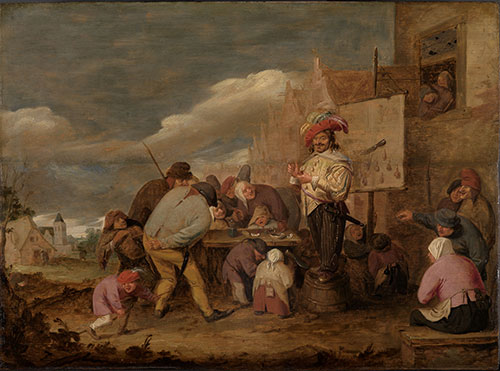
“Der Quacksalber” [Quacksalver] by Adriaen Brouwer that once belonged to Sylvius.
(c. 1630, oil on panel, 45,2×61,8 cm, courtesy Staatliche Kunsthalle, Karsruhe, inv. no.1897).
The finding of calcifications, stones, in this organ led to several speculations. Some reasoned that these findings could never be compatible with the idea of localization of the soul in the pineal gland. Others, who had found such stones in persons with behavioral disorders (including a woman who committed infanticide), believed rather that it proved that the cause was in that organ. By its calcification, the physiological flow of humors in that area was believed to be prohibited (see World Neurology 2017, January, pp. 6-7).
In these discussions, the name of Sylvius (and English physician/anatomist Thomas Wharton [1614-1673]) was often found as opponents to the idea of attributing such a function to the pineal gland. The town physician of Nijmegen, subsequently professor of medicine and anatomy in Utrecht (1649), IJsbrand van Diemerbroeck (1609-1674), published a new edition of his Anatome Corporis Humane (1679; first edition 1672), in which he gave a description of the anatomy and position of the pineal gland, mentioning “arena & calculi” [sand and calcification] that occupied half the volume of the gland, with a reference to Sylvius, who indeed referred to the pineal gland in his Disputationes Medicarem IV (De Spirituum Animalium in Cerebro, Cerebelloque Confectione, per Nervous Distributione, atque Usu Vario). He was much in doubt about its function.
“Know Thyself”
This ancient Greek aphorism is one of the Delphic maxims depicted on a column of the Temple of Apollo. Smith (1999) believed that Sylvius’s painting collection “emphasized the importance of self-knowledge and the effort to achieve moderation in all things, like the numerous fruit and flower still lifes in his collection, which alluded to the ephemeral nature of human existence and the vanity of the things of the world, the message of neostoicism.”
Brouwer’s “Quacksalver” would also fit in this idea of admonition to temperance and several of the themes, also used in the literary arts of the period, including self-knowledge and “insight in the deceptive essence of the world.” It would be recognizable in Sylvius’s inaugural address, when he became professor in Leyden (1658). The painting in Sylvius’s collection gives evidence of his sense of humor as well as the perception of Van Mieris’s and Brouwer’s work among the public. •
FURTHER READING:
Baumann ED (1949). François dele Boe Sylvius. Leiden, Brill
Beukers H (2000). The Sylvian Fissure. In: Koehler PJ, Bruyn GW, Pearce JMS (eds). Neurological Eponyms. New York, Oxford University Press, pp. 51-5.
Houbraken A (1721/1976). De groote schouburgh der Nederlantsche konstschilders en schilderessen. Part III Amsterdam, Israël (see also http://www.dbnl.org/tekst/houb005groo01_01/colofon.php accessed October 1st, 2020).
Smith PH (1999). Science and Taste: Painting, Passions, and the New Philosophy in Seventeenth-Century Leiden. Isis 90 :421-461.
